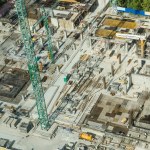
By eliminating the inefficient part of a shear wall, the central portion, and consolidating support members in a much stronger material, steel, a skyscraper could be built with both horizontal and vertical supports throughout. The classic concept of a skyscraper is a large steel box with many small boxes inside it.

Since skyscrapers seek to maximize the floor-space by consolidating structural support, shear walls tend to be used only in conjunction with other support systems. Large structures such as castles and cathedrals inherently addressed these issues due to a large wall being advantageous (castles), or able to be designed around (cathedrals). For skyscrapers, though, as the size of the structure increases, so does the size of the supporting wall.

In this way, shear walls, typically in the form of plywood and framing, brick, or cinderblock, are used for these structures. Due to the features of a shear wall, it is acceptable for small constructions, such as suburban housing or an urban brownstone, to require low material costs and little maintenance. Since the wall material is used to hold the weight, as the wall expands in size, it must hold considerably more weight. A typical example is a brick or cinderblock wall. Other vertical and horizontal loading factors come from varied, unpredictable sources, such as earthquakes.Ī shear wall, in its simplest definition, is a wall where the entire material of the wall is employed in the resistance of both horizontal and vertical loads. Wind pressure increases with height, so for very tall buildings, the loads associated with wind are larger than dead or live loads. In fact, the lateral wind load imposed on super-tall structures is generally the governing factor in the structural design. The wind loading on a skyscraper should also be considered. Vertical supports can come in several types, among which the most common for skyscrapers can be categorized as steel frames, concrete cores, tube within tube design, and shear walls. On the other hand, John Hancock Center's shape is uniquely the result of how it supports loads.
#Skyscraper foundation good code
The Empire State Building's setbacks are actually a result of the building code at the time, and were not structurally required. As such, the amount of structural material required within the lower levels of a skyscraper will be much larger than the material required within higher levels. In technical terms, the dead load, the load of the structure, is larger than the live load, the weight of things in the structure (people, furniture, vehicles, etc.). In most building designs, the weight of the structure is much larger than the weight of the material that it will support beyond its own weight. The load a skyscraper experiences is largely from the force of the building material itself. If bedrock lies close to the surface, the soil on top of the bedrock is removed, and enough of the bedrock surface is removed to form a smooth platform on which to construct the building's foundation. For example, the depth of the pit that holds the substructure has to reach all the way to bedrock. One of the many things that make skyscrapers special is their substructure. When buildings do fail, engineers question whether the failure was due to some lack of foresight or due to some unknowable factor. Thus, no engineer can be absolutely sure that a given structure will resist all loadings that could cause failure, but can only have large enough margins of safety such that a failure is acceptably unlikely. But the only way to know of all modes of failure is to learn from previous failures. This presents a paradox to civil engineers: the only way to assure a lack of failure is to test for all modes of failure, in both the laboratory and the real world. Good structural design is important in most building designs, but particularly for skyscrapers since even a small chance of catastrophic failure is unacceptable given the high prices of construction and potential risk to human life on a massive scale, as seen in the Surfside condominium collapse of 2021. The problems posed in skyscraper design are considered among the most complex encountered given the balances required between economics, engineering, and construction management. Yet they must also be conveniently accessible, even on the upper floors, and provide utilities and a comfortable climate for the occupants. The buildings must support their weight, resist wind and earthquakes, and protect occupants from fire.


The design and construction of skyscrapers involves creating safe, habitable spaces in very high buildings. A workman on the framework of the Empire State Building


 0 kommentar(er)
0 kommentar(er)
